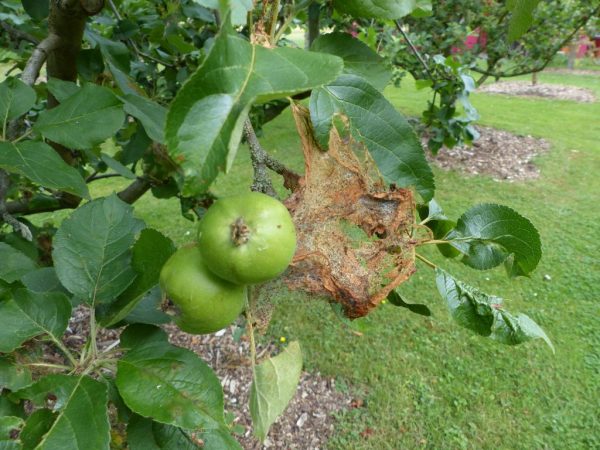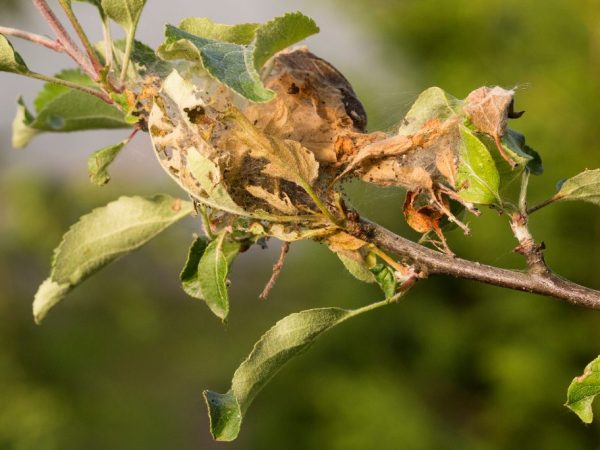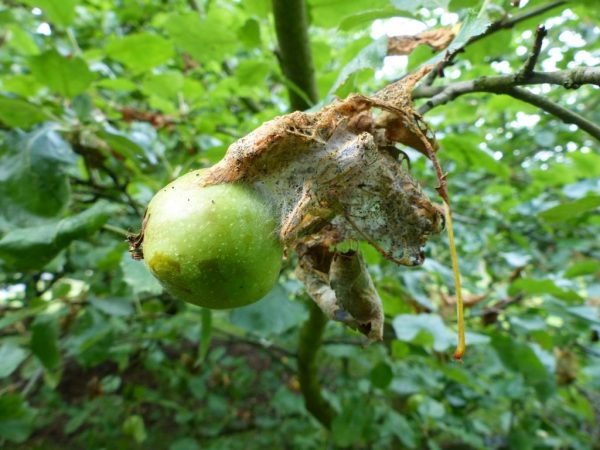Cobweb on an apple tree and methods of dealing with it
During the period of active growth or flowering, the fruit tree can get sick. A cobweb on an apple tree is a sign of damage by pests. In this case, you need to immediately start treatment in order to preserve the yield and the tree itself.

Cobweb on an apple tree and methods of dealing with it
The reasons for the appearance of the cobweb
The cobweb covers the leaves, branches, the whole crown. Its size and density will help determine the type of pest. The tree can be affected by these species:
- spider moth;
- spider mite;
- caterpillars;
- worms;
- aphids.
In the process of vital activity of such pests, the tree is covered with a thin web. Such a grid can be uniform or tangled, branching off from one branch, or scattered in a chaotic manner. This problem cannot be solved mechanically alone. If the root cause is not eliminated, it will not be possible to save the garden culture.
Spider moth
A spider moth is a white butterfly. In the course of her life, she lays hundreds of eggs. A good habitat for the pest is the green branches of young trees. It is attached near the kidneys. Until the moth begins to multiply, spreading the web, you cannot notice the pest.
In winter, he sleeps, is in a kind of suspended animation. It becomes more active in the warm season. In the spring, he gnaws young buds and only then moves on to green leaves.
As a result of such an attack, the foliage begins to dry quickly. The spider web created on top of the branches serves as a kind of framework for parasites: up to 70 new cocoons are attached to it. The larvae grow into pupae.
Only at this stage of development can the gardener see the pest. A butterfly hatched from a cocoon begins to actively lay eggs and feed. The process of destroying the apple tree continues.
Moth detection method
To prevent the danger of moth breeding, the gardener inspects the tree in the fall. A magnifying glass comes in handy for this. The twigs are examined: shields can stand out on them - the first sign that the moth lives on the tree.
If prevention has allowed the detection of the parasite, drastic measures are needed. All dry twigs are cut and burned. Before winter, so that the pest does not hide in the bark of the tree, it is sprayed with a concentrated solution of lime.
In the spring, before the first buds appear, the tree is examined again. If necessary, cut the shields and dry twigs again. For prophylaxis against moths, a special spraying agent is used: 2 ml of "Decis" and a bucket of purified water are mixed.
Caterpillars
If the apple tree is covered with cobwebs, it should be examined for cocoons. The color and shape of such formations will allow you to find out the type of parasite.
Caterpillars often attack apple and pear trees that grow in a large garden. Black, gray and green parasites threaten garden crops. Black caterpillars with blue stripes have a beautiful name - silkworms. During the day they are motionless, and at night they begin to feed - they eat the leaves of the tree.

Caterpillars cause irreparable damage to trees
Green caterpillars are called moths. This parasite has characteristic light stripes on the sides. They feed on the kidneys first. When the latter are destroyed, the caterpillars move onto the leaves.
Gradually, a large group of these pests destroys the whole tree. To prevent the appearance of green larvae, in the fall, before the arrival of frost, trapping belts are put on the tree.
Gray caterpillars have characteristic hairs on their bodies. Unpaired silkworms, as they are also called, easily move from one culture to another. If pests appear on an apple tree, there is a high probability that they have spread to it from another tree in the garden.
It is necessary to inspect all horticultural crops. If the gardener noticed "masonry" in the spring, they must be completely removed - scraped off with a knife.
Worms
The worms living under the cobwebs, which are smaller in size than caterpillars, are moths.
First, the butterfly lays its eggs. They are located on the back of the plate and are very difficult to spot. Caterpillars emerge from them two weeks later. Their length is no more than 20 mm. A distinctive feature of pests is that a dark head stands out against the background of a light calf.
In the spring, the worms feed on the buds and buds of the apple tree. After that, pupae appear - their diameter is no more than 10 mm. Then the life cycle of the parasite is repeated. With a large number of such worms, the apple tree may die.
Leaf roll
Another type of worm that causes the leaves to shrink into tubes is the leaf roll. It not only creates a small cobweb, but also completely deforms the sheet plate.
The pest differs in the location of the wings: if in other moths they are vertical, then in the leafworm they are horizontal. The color of the butterfly is gray, sometimes white. The average wing length is 20 mm.
If you see a leaflet, you need to take the following measures:
- first aid - mechanical removal of cocoons;
- the caterpillars are shaken off and burned;
- use chemicals to treat the entire tree.
Beetle leaf
A similar pest starts on a seedling. He rarely lets out a thick web, but destroys foliage. Beetles are small insects. Their body size does not exceed 3 mm. They lay yellow eggs on the bark or near the first buds.
Eggs are stored in the bark until the ambient temperature rises. After that, larvae appear from them. At this stage of development, pests feed on tree sap.
In the process of their vital activity, leaf flies leave excrement: these are white spots that can be seen on a young apple tree. On them, if the garden culture is not treated, a fungus appears.

Beetles can destroy foliage
Over time, the foliage darkens. Further, the leaf plate dries up and falls off. Adults from the larvae appear after the flowering of the apple tree. They form transparent wings. By the end of summer, adults lay eggs, and in the spring their life cycle repeats. To prevent the reproduction of parasites, after winter, young trees are sprayed with an infusion of ash.
Spider mite
If a thick web appears on the seedlings, the pest is a tick. The insect is small in size, so it will not be possible to see it with the naked eye. First, the pest lays eggs on seedlings, from which a tick appears after two weeks. It lives on stems and feeds on green foliage.
Another type of parasite is the red mite. It has a characteristic purple color. The body is small in size. The female grows up to 0.5 mm in length, and the males grow up to 0.3 mm.
The signs of mite parasitism are creamy spots on the foliage. These are larvae laid by adults. The cobweb that the tick leaves is thin and breaks quickly.
If there is a draft on the land, the larvae of the parasite from the torn off cobweb fall on other trees. The tick is carried around the garden. Timely cleaning is a preventive measure against ticks.Fallen leaves and dry branches are immediately burned, and the old bark is ripped off.
Spider aphid
Often a spider aphid appears on a tree where a tick already lives. The second pest multiplies very quickly. The female is capable of laying up to 100 eggs at a time. Parasites feed on sap, leaves, buds. Aphids can have different colors and differ in the size of adults.
She wraps cobwebs around the foliage, after which the green plates darken, curl and fall off. New larvae appear in the spring. They grow within a month. Adults can move to other trees.
Apple is threatened by these types of aphids:
- green. There is a pest on young trees. It leaves behind characteristic black spots - they are visible on foliage and young stem. The name of the spot is sooty fungus. In one life cycle, a female green aphid produces up to 10 generations of offspring. As soon as it gets colder, she lays eggs and hides them under the kidneys;
- gray. It appears more often on mature apple trees. Due to its activity, the leaves swell, then they lose their color, dry and fall off.
Other reasons
The leaves of the apple sucker are striking. Such a pest also covers a healthy tree with cobwebs. The larvae feed on sap and secrete a sticky substance - the leaves stick together. The parasites feed on green foliage.
If large cocoons are visible, and there are few cobwebs, then the hawthorn struck the apple tree. Caterpillars hibernate on a tree, and become more active by spring.
Pest control
When the apple tree is sick, the gardener conducts a series of activities. Visible parasites or their cocoons are removed mechanically. After that, all the bark and leaves are treated with special agents.
They choose treatment with folk methods or microbiological preparations. They affect the bark and foliage, destroying not only adults, but also larvae invisible to humans. To make it easier to deal with pests, prevention is carried out in the fall and early spring.
Folk remedies

Spraying will help get rid of pests
The choice of means directly depends on the type of pest. The first step is to determine the reason why the cobweb appeared on the apple trees. In the presence of a sucker, such folk remedies are used:
- spraying is the easiest and most affordable way to destroy larvae and adults. For this, a solution of ash is prepared or a tincture of yarrow is diluted with water. Soap solution is used when it is necessary to wash the crop from a pest of unknown origin. You will need a concentrated solution. With its help, sick and healthy leaves are washed. During the procedure, the gardener protects the hands and exposed areas of the body;
- fumigation. Another easy way to get rid of pests is to fumigate the tree. To do this, you need a bunch of straw, 2 kg of tobacco or tobacco dust. Piles are laid out near sick trees and set on fire. They burn for at least 2 hours. Long-term exposure to corrosive smoke will drop the pests to the ground. After that, you need to completely dig up the top layer of soil around the tree;
- wetting the infected bark with tincture. A tincture of nettle is used to kill the larvae. You need 1 kg of fresh grass. It is boiled, and the whole tree is washed with this solution. You can use fresh nettles. It is soaked in hot water, and then the tree is treated with this composition.
Use of drugs
Biological preparations will help fight pests. If spraying with wormwood tincture does not help in scaring away caterpillars, then Bitoxibacillin is used.
A concentrated preparation is used only under certain conditions: the weather should be warm and not rainy. At low air temperatures, the drug is not used.
Effective against the Nitrofen tick. It is a powerful poisonous substance, therefore it is used at a distance of at least 200 m from the living quarters. Good results are shown by "Verticillin".It helps in cases when leaves curl on a tree and a thick web appears.
Prophylaxis
If you deal with this problem systematically, aphids or ticks will not appear. It is especially important to pay attention to the prevention of seedlings. To prevent pests from appearing on the land, the following measures are necessary:
- be sure to weed the soil - the fewer weeds, the fewer pest larvae;
- root growth is a threat to the seedling, so it must be cut off immediately;
- you can not plant flowers near the apple tree;
- feeding a tree will strengthen its protective mechanisms;
- pruning is carried out before the growing season;
- if wounds appear on the bark, they must be treated immediately - use disinfectants;
- if there are hollows in the apple tree, they need to be closed.
Prevention is also timely pruning of diseased branches and cleaning shoots from twisted or dry foliage.
The apple tree is an unpretentious tree to care for. It requires minimal watering and fertilization. More often the culture suffers from pests than from a lack of moisture or nutrients.
When a cobweb appears on a seedling or an adult tree, you need to inspect the branches - there is a high probability that a tick, aphid or a caterpillar has wound up.
By external signs, it will be possible to determine the type of pest - then all measures taken to combat parasites will be more effective. Timely prevention will help protect the crop in the autumn and spring, when pests are activated.

